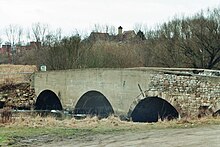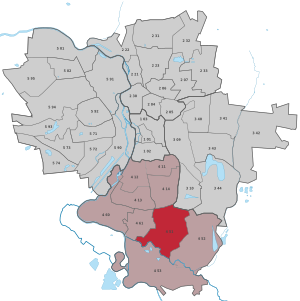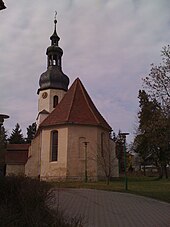Ammendorf / Beesen
|
Ammendorf / Beesen district of Halle |
|
|---|---|
| Coordinates | 51 ° 25 '37 " N , 11 ° 58' 57" E |
| Residents | 7014 (March 31, 2019) |
| Incorporation | Jul 1, 1950 |
| prefix | 0345 |
| Transport links | |
| Federal road |
|
| railroad | RB 25 |
| Train | S 7 |
| tram | 5 95 |
| bus | 24 28 97 724 |
The location Ammendorf / Beesen is a district of the Ammendorf district in the southern district of the city of Halle (Saale) and is north of the White Elster with 7014 inhabitants . It consists of the formerly independent villages Ammendorf and Beesen, as well as the Rosengarten district south of Kasseler Straße .

history
The first evidence of settlement in the area comes from the Neolithic Age . Ammendorf was first mentioned in a document in 1214 in the city of Halle's document book. A noble family of the same name " von Ammendorf " came from the place.
Ammendorf, Beesen and the neighboring towns of Burg in der Aue and Planena were located in the southernmost part of the hall circle belonging to the ore monastery of Magdeburg . While Burg in der Aue was under the administration of the Giebichenstein Office , Ammendorf, Beesen and Planena belonged to the theological faculty in Halle . The jurisdiction of the manor Beesen included u. a. the places Ammendorf, Peißen (near Hohenthurm), Pritschöna and Wesenitz. In 1680, the places on the border with the Electoral Saxon Office of Merseburg with the Saalkreis came to the Duchy of Magdeburg under Brandenburg-Prussian rule.
With the Peace of Tilsit in 1807, the four places were incorporated into the Kingdom of Westphalia and assigned to the Halle district in the Saale department. They came to the canton of Glaucha . After Napoleon's defeat and the end of the Kingdom of Westphalia, Napoleon's allied opponents liberated the Saalkreis in early October 1813. During the political reorganization after the Congress of Vienna in 1815, Ammendorf, Beesen, Planena and Burg were attached to the Merseburg administrative district of the Prussian province of Saxony in 1816 and assigned to the Saalkreis.
On April 1, 1917, Beesen was incorporated into Ammendorf. Planena followed on May 1st, 1920 and Burg in der Aue on June 1st, 1920. Ammendorf received town charter on December 15, 1937, which the place retained until it was incorporated into Halle on July 1, 1950.
Districts
Ammendorf
Ammendorf extends over the eastern areas of the district and used to be an independent place with approx. 21,000 inhabitants and an area of approx. 1935 ha. The center of the village is marked by the village church of St. Katharinen , which is located on a hill above the northern edge of the Saale-Elster -Aue stands.


Ammendorf played a major role in the industrialization of the city of Halle. The use of lignite , which was mined in the Ammendorfer district, began early on . The world's first briquette factory was established in 1858 (System Ing. Carl Exter ). Later industrial settlements of the chemical industry and mechanical engineering took place. The best known was Waggonbau Ammendorf ( LOWA ), founded as Waggonfabrik Gottfried Lindner AG .
One of the largest poison gas factories in Germany, Orgacid GmbH , was also located in Ammendorf . Up to 1945 approx. 26,000 t of the warfare agent S-Lost ( mustard gas ) was produced here, but was no longer used during the Second World War . Under the former Ammendorfer company premises on today's Camillo-Irmscher-Straße there are eight widely ramified green-tiled cisterns that were difficult to detoxify due to the lack of building plans and were hermetically sealed after the fall of the Wall . Nevertheless, in 1990 30 tons of toxins came to the surface through the groundwater. In Ammendorf, a very popular and always well-frequented summer outdoor pool was in operation from 1933 (deedication as a public facility: 2010, demolition: 2013), which offered leisure and recreation space for the south of Halle until it was closed for cost reasons after the end of the 2003 summer season.
Beesen
Beesen is significantly smaller than Ammendorf and extends over the western area of the district.
In the manor Beesen 1594 a brewery was built. The brewing malt was supplied by Böllberger Mühle. The beer was called Broihan and was sold in the Ammendorfer Broihan tavern . Today Beesen is mainly known for the Maya Mare water park . In Beesen is the last stop Beesen the tram hall . The 12th century church of St. Elisabeth is worth seeing .
traffic
The federal road 91 leads through Ammendorf ; east of the village is the Halle-Ammendorf train station on the Thuringian Railway, which runs in north-south direction . Tram line 5, operated by Hallesche Verkehrs-AG , runs parallel to this and ends at Halle-Ammendorf station or continues on the Halle-Ammendorf-Bad Dürrenberg tram route in the direction of Merseburg and Bad Dürrenberg . In addition, the Rosengarten depot and the Halle-Ammendorf depot, which has since been removed, are located in the district . At the terminus at the train station there is a transition to the HAVAG city bus routes 24 and 28; While the former connects the Radewell / Osendorf district with the Südstadt (Halle) district and also serves Beesen and the Halle-Silberhöhe district , line 28 crosses the area of Ammendorf and represents an alternative connection between Ammendorf and Rosengarten. In addition, from Ammendorf the Line 724 can be used, which runs between Merseburg in the Saale district and Schkeuditz in the northern Saxony district .
Sons and daughters
- Georg Friedrich Meier (1718–1777), philosopher, born in Ammendorf
- Ernst Baumhard (1911–1943), gassing doctor at the Nazi killing centers in Grafeneck and Hadamar
- Werner Piechocki (1927–1996), senior archivist, director of the Halle city archives, born in Ammendorf
- Wolfgang Engel (1928–2010), mathematician, born in Ammendorf
- Helga Schmidt (1937–2018), three-time Olympic participant in swimming , born in Ammendorf
- Jutta Hoffmann (1941), actress, born in Ammendorf
literature
- Wolfgang Engel: Ammendorf. From the beginning to the present , 2nd edition 2001.
- Peter Findeisen and Dirk Höhne: The village churches in Halle (monument sites - monument values vol. 3). State Office for Monument Preservation and Archeology Saxony-Anhalt - State Museum for Prehistory, Halle 2006, ISBN 3-939414-00-X ; to St. Katharinenkirche in Ammendorf, pp. 22–31; on St. Elisabeth's Church in Beesen, pp. 32–45.
Web links
- City of Halle: District location Ammendorf / Beesen
- Official website about Ammendorf at ammendorf.de
- Ammendorf in the Wildenfels Castle Archive at schlossarchiv.de
- Beesen in the Schlossarchiv Wildenfels on schlossarchiv.de
- Halle (Saale) in figures on halle.de (PDF; 309 kB)
- Files and plans for the Ammendorf train station in the holdings of the Reich Railway Directorate in Halle in the Saxony-Anhalt State Archives, Dessau department
Individual evidence
- ^ City of Halle: districts
- ↑ Quarterly Report Hall 2019/1. Retrieved June 27, 2019 .
- ^ City of Halle: Overview of the city structure
- ↑ Mention of the Ores in the book "Geography for All Stands", pp.124 and 128f.
- ^ History of Ammendorf
- ^ Description of the Saale Department
- ^ The hall circle in the municipality register 1900
- ↑ Beesen on gov.genealogy.net
- ↑ Planena on gov.genealogy.net
- ^ Castle on gov.genealogy.net
- ↑ Halle (Saale) and its districts on gov.genealogy.net
- ^ Halles Sommerbad disappears , Mitteldeutsche Zeitung online from July 7, 2013, accessed on November 6, 2013.
- ↑ https://www.halle-im-bild.de/fotos/residenzen-burgen/rittergut-beesen
- ↑ https://www.halle-im-bild.de/fotos/geschaefte-gaststaetten/broihanschenke-ammendorf-beesen
- ↑ Street directory Ammendorf / Beesen, Halle (Saale). Retrieved May 6, 2020 (map view).



